NIH expands initiative to encourage bench-to-bedside research
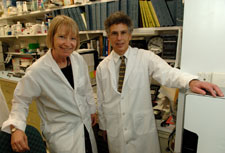 |
Primary investigators Dr. Maret G. Traber (left), Oregon State University, and Dr. Mark A. Levine (right), NIDDK, received a bench-to-bedside award for their research project on women's health--"Vitamin E Pharmacokinetics and Oxidative Biomarkers in Normal and Obese Women."
|
NIH has awarded nearly $4 million to fund 19 bench-to-bedside medical research projects designed to speed translation of promising laboratory discoveries into new medical treatments.
For the first time, applications for these awards, first given in 1999, were open to research teams made up of NIH intramural and extramural collaborators from medical schools, health-care organizations and private industry. All but one of the funded projects include extramural partners; nine of the 19 projects involve researchers from two or more NIH institutes or centers.
"The new bench-to-bedside awards program is a good example of NIH's commitment to transforming medicine through discovery," said Dr. Elias A. Zerhouni, NIH director. "It encourages innovative partnerships between extramural and intramural researchers and opens new opportunities for advancing medical science."
The bench-to-bedside research program was created within the Clinical Center as a way to encourage collaboration between basic scientists in the laboratories and clinical investigators who work with patients, said Dr. John I. Gallin, CC director. "Historically, a hallmark of this program has been support for projects that involve partnerships between basic and clinical scientists from across institutes at NIH. The new component started this year greatly expands the partnerships in medical research to government and non-government scientists."
This year, awards in four categories were funded by the NIH Office of Rare Diseases; the NIH Office of AIDS Research; the National Center on Minority Health and Health disparities; and the NIH Office of Research on Women's Health. A fifth category was co-funded by sponsoring institutes and, for the projects' extramural components, the NIH National Center for Research Resources. Project teams receive up to $200,000 over two years to support their work
This is the first year projects in minority health and health disparities and women's health have been specifically funded. Quality of the science, promise for becoming an active clinical trial, and potential for offering a new medical treatment or better understanding an important disease process were among selection criteria.
Eight teams received funding for investigations focusing on rare diseases:
- NHLBI, Clinical Center, Harvard University, Georgetown University Medical Center and National Naval Medical Center
- NHLBI, Clinical Center and Walter Reed Army Medical Center
- NHLBI and M.D. Anderson Cancer Center, with associate investigators from the National Institute of Diabetes and Digestive and Kidney Diseases and the Medical College of Virginia
- National Cancer Institute and NHLBI, with associate investigators from the National Institute of Neurological Disorders and Stroke and Sloan-Kettering Cancer Center
- NCI, with associate investigators from the University of Southern California, the Barbara Ann Karmanos Cancer Institute and Wayne State University, the Fred Hutchinson Cancer Research Center, the University of Washington and Mayo Clinic College of Medicine
- Clinical Center, NCI, University of Toronto/Ontario Cancer Institute, with associate investigators from the University of Illinois
- NIDDK, NHLBI and the University of Maryland
- NHLBI, Clinical Center, with associate investigators from NCI, NIDDK and Drexel University
Four teams will conduct AIDS-related studies:
- NIAID and St. Michael's Medical Center
- NCI, NIAID and Johns Hopkins University
- Clinical Center, NCI, San Francisco General Hospital and Science Applications International Corporation (SAIC-Frederick), with associate investigators from Mulago Hospital, Makerere University, in Uganda
- NIDDK and the Children's National Medical Center
The work of four teams targets minority health and health disparities:
- Clinical Center and NHLBI
- NIDA and University of Pennsylvania
- National Human Genome Research Institute and Fred Hutchinson Cancer Research Center
- NICHD, NIDDK and the University of Wisconsin.
A team from NIDDK and Oregon State University will conduct research related to women's health.
The NIH National Center for Research Resources is co-funder for two projects, one conducted by NIDDK and Washington Hospital Center and another involving the National Institute of Neurological Disorders and Stroke, National Eye Institute, Johns Hopkins University School of Medicine and the University of Pennsylvania.
More information on these projects is online at http://www.cc.nih.gov/ccc/btb/.
Back to Top
George Patrick retires from CC's recreational therapy section
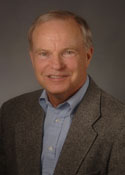 |
|
Dr. George Patrick, chief of recreational therapy, retired in July 2006.
|
Known for bringing relaxation to CC patients, Dr. George Patrick, chief of recreational therapy, has opted to start some relaxing of his own—he retired from his position in June 2006.
Patrick began his NIH career in June 1988 as a special assistant in training in the recreational therapy section. "The available treatments were different back then," he said. "At the time, our department compiled a list of what patients were doing—things like tai chi and other relaxation techniques—and we also looked at what patients were asking for." With that information, Patrick and others began forming discussion groups to determine what new offerings they could bring to the CC.
"My goal since I began here," he said, "has been to improve the quality of life for patients and to work collaboratively with NIH staff and other professionals in biomedical research." As he began to investigate progressive relaxation methods, Patrick gained a better understanding of those techniques and would make them available to CC patients. Today patients can take advantage of a host of options, including acupuncture, biofeedback, massage, meditation and music therapy, to name a few.
One of the patients' most popular requests was for animal-assisted therapy, in which volunteers bring their dogs to visit with patients. "Patients loved spending time with the dogs. And the dogs and their owners enjoyed visiting with the patients."
Patrick's professional interests include behavioral medicine, psychology of health, immunity and disease and integrative models of mind-body healing—all areas of study he plans to continue working with after retirement.
"I think I've done a pretty good job of passing on my responsibilities and duties, and I feel good about it," he said. "We've come a long way, but there is still plenty more ground to cover."
Before coming to NIH, Patrick worked at the University of Georgia, where he was an assistant professor, a special assistant with the patient activities department and coordinator of the therapeutic recreation department. He also was director of activities therapy at Virginia's Portsmouth Psychiatric Center. He has served as president of the Southeast Therapeutic Recreation Symposium's board of directors and has taught courses on leisure education, recreation for special populations, adapted physical education and group dynamics in social recreation.
Patrick is the author of 41 publications that cover such topics as complementary and alternative medicine, novice wheelchair athletics, developmental psychology and geropsychiatric recreation, and day camping for developmentally disabled children.
Originally from Athens, Ga., Patrick will return to his home state in order to retire near his two grandchildren.
—By John Iler
Back to Top
Safra Lodge celebrates first year of service to CC families
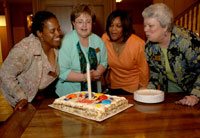 |
|
Safra Family Lodge staff members Dilcia Stephens-Medley, Jan Weymouth, Ellen Williams and Margo Bradford blow out the single candle on the cake, celebrating the LodgeÍs first year in operation.
|
The Edmond J. Safra Family Lodge opened its doors to the first guest one year ago. In honor of that milestone, the Clinical Center family gathered on June 1 to celebrate the hard work and dedication of all the individuals who toiled during the construction years and who continue to ensure a high-quality experience for visitors today.
The Safra Family Lodge provides a home away from home for the caretakers and family members of Clinical Center patients. With all the amenities of home, guests can take advantage of the expansive gardens, well-appointed living spaces and fully stocked kitchen, while their loved ones receive care at the nearby Hatfield Center.
CC staff and Lodge guests were invited to attend the informal anniversary party. Complete with "birthday" cake and food donated by the Foundation for the National Institutes of Health, the event honored the dedication of all the individuals responsible for the construction, maintenance and success of the Lodge. The design architect, Amy Weinstein, was on hand for the celebration, making it her first visit to the completed Lodge since it opened for business. Also in attendance were many of the facilityÍs management and housekeeping staff, who continue to be critical to the Lodge's success.
For Lodge staff members Margo Bradford, Dilcia Stephens-Medley, Ellen Williams, Annie Harrison and executive director Jan Weymouth, the event was a special opportunity to host their CC family at the place they refer to as their second home.
"I love this place," said Williams. "I sometimes drive here on the weekends just to see if everything is okay—it is my other home."
Back to Top
Dr. Lynnette Nieman presents 2006 Decker Memorial Lecture
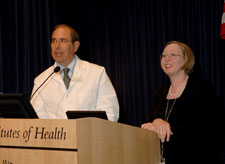 |
Dr. Lynnette Nieman (right), senior investigator in NICHD's Reproductive Biology and Medicine Branch, was named the NIH Fellows CommitteeÍs 2005 Distinguished Clinical Teacher. .
|
Now in its fourth year of honoring the National Institutes of Health's leaders in clinical teaching, the 2006 John Laws Decker Memorial Lecture highlighted the accomplishments and research of Dr. Lynnette Nieman. Named the NIH Fellows Committee's 2005 Distinguished Clinical Teacher—the highest honor bestowed collectively on an NIH senior clinician, staff clinician or tenure/tenure-track clinical investigator by the NIH Clinical Fellows—Nieman was invited to deliver the 2006 Decker keynote address.
Currently a senior investigator in NICHD's reproductive biology and medicine branch, Nieman came to NIH in 1982 as an NICHD medical fellow. In the years following she was appointed to the NIH Clinical Center Board of Governors (now known as the NIH Advisory Board for Clinical Research). She was clinical director of NICHD from 1991 to 2001, and for two of those years was chair of the Medical Executive Committee. She has conducted research on disorders of hypercortisolism and on antiprogestins as therapeutic agents, authored hundreds of papers and sponsored three investigational new drug applications to the FDA.
Her primary research focus is on Cushing's Syndrome—a disorder caused by prolonged exposure of the body's tissues to high levels of the hormone cortisol. For her Decker lecture, she spoke on "Designing Clinical Studies: Lessons from Cushing's Syndrome," detailing her experiences in designing and administering clinical studies.
She described the history of her 25-year research endeavors that were designed to advance the care and understanding of patients with Cushing's. She touched on the importance of mentors and teamwork when working on such a complex undertaking. "There is not one great clinician or teacher here, but many people who fit [the award] description and could have received this award," she said.
Nieman went on to discuss lessons she and her team learned as they labored to develop tests to identify Cushing's patients. She candidly shared the successes and challenges of creating a test that seemed to give accurate results, only to be forced to abandon it later when the results were not up to par. "Be willing to give up on a test, even if you are the one who developed it," she advised.
Before beginning her presentation, Nieman acknowledged the members of the Decker family in attendance—Decker's daughter Megan and son David. "I knew John Decker when I was here as a young fellow," Nieman said. "I remember being intimidated by him but appreciative of his affirmation of clinical care and clinical research."
John Laws Decker began his career at NIH in 1965 as chief of the Arthritis and Rheumatism Branch, which is now the National Institute of Arthritis and Musculoskeletal and Skin Diseases. He was director of the NIH Clinical Center from 1983 to 1990 and was named scientist emeritus following his retirement.
The 2006 Distinguished Clinical Teacher Awardee will be announced by the members of the NIH Fellow's Committee at Clinical Center Grand Rounds this fall and will be the invited lecturer at the fifth Annual John Laws Decker Memorial Lecture, as part of the Great Teachers series of Grand Rounds, in June 2007.
Back to Top
Betty Peterson retires after almost four decades of CC nursing work
After serving the needs of CC patients and nurses for almost four decades, Betty Peterson retires this month with 39 years of memories working with nine nurse managers, hundreds of staff nurses and thousands of patients—most recently as a research support assistant for 5NW.
A native Washingtonian, Peterson graduated from McKinley Technology High School in 1961. She attended Temple Business School, where she studied data processing, but she soon realized that her true calling was nursing. "I had always wanted to be a nurse," Peterson said. "I enjoy taking care of people in need."
Peterson worked and took nursing classes at the Washington Hospital Center from 1966-67. She came to NIH in 1967, where she worked as a nurse's aid on 9 East for a year before taking a year off to care for her two young daughters at home.
 |
Betty Peterson retired in July 2006.
|
Peterson returned to NIH in 1969 to work on 8 West (now 5NW). There she worked the day, evening or night shift for 20 years, followed by 18 years as a full-time, night-shift nurse. Betty was a lifesaver on many different levels. She consistently kept the charge and staff nurses aware of changes in patients' conditions through her astute observations and monitoring of vital signs. According to her colleagues, having Peterson on duty was like having two nurses' help, as she could pick up on the smallest discrepancies on a patientÍs care plan. She was an outstanding resource for many new and veteran nurses.
Peterson played a key role in the multitude of tasks required for each new patient—obtaining and charting vital signs, helping them prepare for tests and surgeries, setting up for phlebotomy and preparing worksheets for the day shift. Despite typical Sunday admission schedules of 20 patients, Peterson managed to complete these and her other night-shift duties efficiently and cheerfully.
According to her fellow nurses, Peterson was known for her organizational skills. Her caring, can-do-and-will-do work ethic earned her several Excellence in Administrative and Clinical Support awards during her CC career.
Peterson will stay busy at her home in Washington caring for her 97-year-old mother and helping her two daughters and brothers. She hopes to catch up on some much deserved sleep, after more than 29 years of working nights, and she hopes to vacation in California and Canada sometime in the next few years.
—By Louise Canada, Nurse Historian
Nursing and Patient Care Services
Back to Top
CC fellow shares his first-hand experience on the ground in Iraq
Maj. Milad Pooran is an allergy and immunology fellow with NIAID and a major in the District of Columbia Air National Guard/United States Air Force (USAF). In July 2006, when he returns from service in Iraq, he will be a fellow in the Clinical CenterÍs Critical Care Medicine Department. During his time overseas, Pooran has shared some of his first-hand experiences with family and friends through e-mail correspondence. His stories give a unique glimpse of life on the ground at the USAF level-three trauma center in Balad, Iraq. Reprinted below are excerpts from some of his messages home.
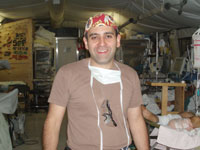 |
Maj. Milad Pooran, an allergy fellow with NIAID, at the U.S. trauma center in Balad, Iraq.
|
May 14, 2006
To say the least, it has been an exciting first week thus far in Iraq. There is so much to tell you about, but I will try to hit the highlights.
The start of my trip to the desert was uneventful. I flew to Al 'Deid Air Base in Qatar, a small nation off the western coast of the Arabian Peninsula. We were in the 'Deid for two and half days, during which time we started to acclimate to the 108 degree weather before going to Balad, Iraq.
The hospital here in Balad is one of the best trauma centers in the world, and I would hazard to say, the quality and level of care rivals any major center in the United States. The predominantly Air Force staff, along with the Army and Navy, have developed a seamless network of care that ensures the best level of care possible for our troops. Our survival rates here are exceptional and are a direct credit to the level of training and medical practice devised in the States.
We got plugged into the work rotations from day one, and I have started to see patients. I was originally assigned to the ER, but with my internal medicine background and an imbalance of staff in the ICU, I have been made one of the ICU attendings.
Our breakdown for trauma includes U.S. and Iraqi forces along with injured insurgents and the too-often victims of terrorist attacks. We recently had four children ranging in age from seven to nine years, all of whom had been near a suicide bomber in their school.
My first day in the ER, I was performing a lumbar puncture when we came under mortar attack. We heard the bang, then three seconds later the alarm for incoming. We all took cover and then proceeded to finish the procedure in full body armor, including vests and helmets.
Today I admitted a five-year-old who had been shot in the head during an attack on a checkpoint. Fortunately the bullet grazed his skull and despite a small subdural and scalp hematoma, I was able to get him extubated within an hour of arrival. The first thing he asked for was his mom and he settled nicely once she arrived. God bless for small miracles.
I have been working almost 16-hour days, but the work is rewarding. The people here are professional and the mood is light. As an internist I am getting an incredible learning experience dealing with pediatric ICU patients and trauma patients. I should be primed for my upcoming year at the NIH.
June 3, 2006
By now many of you have seen the television show "Baghdad ER." The Armed Forces Network will not air the show here because they feel it is too gory. Therefore, I can't vouch for its accuracy, but I can say that work here in Balad is certainly not for the faint of heart. A typical scenario starts when a trauma call is sent out over the hospital address system. This prompts the trauma surgeon on-call, along with lab, pharmacy, radiology, respiratory therapy and blood bank [personnel], to rush to the ED. The ER staff is already in place, gowned and geared. Once a trauma call goes out, the vehicle of transport (mainly army helicopters) arrives within 30 seconds. Notification time is short.
We suffered our first mass casualty a couple of weeks ago. This is stuff we train for, but until you are in the midst of one, you donÍt realize how important all the training truly is. The problem is that you never know when a mass casualty will hit, and every time a helicopter brings a trauma patient in, he or she could be the first of seventy.
Two nights ago a flight surgeon and I were walking through the ED in the midst of a multi-trauma (it was my night off). We both gloved up and helped in assisting two physician assistants with placing chest tubes and lines. I was in my PT gear and tennis shoes at the time (I now have blood on every pair of shoes I brought here except my flip-flops). The work hours here are long and tedious.
I often talk with the Marines and soldiers who are out and about. I am awed by their stories. I am so proud of these young men and women for all the hard work they do and for their focus and determination. It really makes me proud to be an American. I was talking with a Marine, a 24-year-old from Wyoming, about some of his first-hand experiences. We were at the bedside of an Iraqi woman who had been critically injured by an IED at his checkpoint six hours earlier. This Marine and his Navy Corps medic had extracted her from a burning vehicle and provided life-saving and resuscitative measures. I was absolutely inspired by this man's bravery and his "cool-under-pressure" attitude. More amazing was that he said to me, "We sure are grateful for you guys. We could never do what you all do." All I could muster was to repeat the same words back to him.
The days are getting nice and toasty here. We topped out at 115 degrees the other day. But the nights here are cool and the sunsets beautiful. The other day I was biking to the chow hall and the smell of burgers on the grill almost made me think I was in Ocean City on a warm summer's day. Miss you all.
—Milad
Back to Top
Emergency drill tests preparedness of CC staff
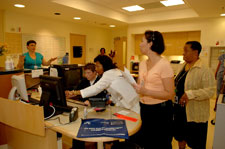 |
|
Mary Sparks speaks to the nursing staff in the 5SW North patient care unit as a simulated fire is announced in their location. The drill was designed to test the Clinical CenterÍs level of emergency preparedness.
|
A simulated fire and patient evacuation drill was held June 6 to test the Clinical Center staffÍs level of emergency preparedness. Although CC staff knew the drill was scheduled, the location of the emergency was not known until the alarm sounded in the 5SW North patient care unit at 1 p.m.
With the announcement that a fire had consumed half of the 5SW North unit, the NIH fire department arrived at the scene and nurses "evacuated" the patients. Because this was a simulated disaster, pieces of paper were used to represent patients. Nurses placed the "patients" in wheelchairs and transported them away from the area.
With the call for evacuation, the CC moved into Code Yellow status, activating its emergency management plan. The public address system announced the Code Yellow drill and broadcast instructions to every CC sector. Each department and unit followed its emergency procedures, while the command center provided updates by e-mail and telephone.
The drill was performed to test the CC's communication strategies, assess unit evacuation procedures and allow departments and institutes to test their local emergency plans.
Back to Top
New lab coat laundry process cuts costs, brings new challenges
Just as football players wear helmets, lawyers don suits and cowboys wear boots—health care workers and scientists are identified by their white laboratory coats. The CC Department of Housekeeping and Fabric Care (HFCD) has for many years made sure that the men and women in white have a clean and wrinkle-free wardrobe. However, the valet laundry service of the past was replaced in May 2006 with a process that HFCD admits has had a few wrinkles of its own.
Before May, all NIH customers placed their lab coats outside their offices and laboratories for pick-up. About four days later, the coats would be returned clean and ready to wear. HFCD laundered all NIH linens, regardless of whether or not they belonged to CC employees.
"Because of a constricted budget, the valet service is a luxury we can no longer afford," explained HFCD chief Henry Primas. "We had to come up with a system that still got lab coats cleaned, but in a more financially responsible way."
The solution was an internal dry cleaning service available only to CC and institute employees who work directly with CC patients. Other customers can contact the HFCD office for a list of external dry cleaners with which NIH has established purchase agreements.
"With this new system, the Clinical Center saves about $500,000 per year," Primas said. "The entire set-up, including construction and machinery, has cost less than $20,000."
The new laundry process requires customers to bring their lab coats to the B2 level of Building 10, where signs direct them to the lab coat area. When dropping off their coats, employees must show their NIH identification cards; the laundry technician cannot accept coats without seeing an ID. Once a coat is dropped off, it is sent out to be cleaned and pressed. In about four days, the clean coats are returned and customers can pick them up in the B2 area.
Like any new business, its employees are learning as they go„developing solutions for problems as they arise. One of the challenges has been matching coats to their original owners. Many of the identifying tags wash away in the laundry process, leaving no way to match the coat with a specific order. The HFCD staff ask that all employees write their names in permanent ink inside their coats so they can be properly identified even without a dry cleaning tag.
HFCD technician Marshall Logan helps customers place and pick up orders. Working on the front lines, Logan often must deal with some less-than-satisfied customers. He tries to remain friendly, and if he is not able to find their coats, he will offer a loaner lab coat.
"We understand it's new to everyone and we want to extend our customers the highest consideration," says Chauncey Buford, HFCD supervisor. "We also ask that the same consideration be applied to us. This is new to everyone, including us. We are essentially in a new business."
Some facts to remember about the lab coat process
- Drop-off and pick-up is located on the B2 level of Building 10.
- Hours of operation are 8 a.m.-3:30 p.m. daily, closed on weekends.
- Customers must bring an NIH ID card when dropping off and picking up orders.
- The service is available only to CC and institute employees who work with patients in the CC. (NIH students without employee badges may use the service, but they must be accompanied by an NIH employee with a valid ID badge when dropping off an order.)
- Customers are encouraged to write their last name and first initial in the inside collar of their lab coats in permanent ink.
- When picking up an order, customers will need to take the entire order at once.
—By Kathryn Boswell
Back to Top
Conference celebrates nursing achievements in clinical research
 |
|
Drs. Patricia Grady, NINR, Christine Miaskowski, University of California, San Francisco, and Clare Hastings, CC Nursing and Patient Care Services, at the June 16 Celebrating Nursing Science conference.
|
As part of the year-long celebration marking the 20th anniversary of the National Institute of Nursing Research, NINR and the Clinical Center’s Nursing and Patient Care Services hosted the conference, “Celebrating Nursing Science: The Research Practice Link,” on June 16 to celebrate achievements in clinical nursing research and their application to practice.
Dr. Patricia Grady, director of NINR, and Dr. Clare Hastings, chief of CC Nursing and Patient Care Services, welcomed the audience to Masur Auditorium and introduced the event’s keynote speaker— Dr. Christine Miaskowski, professor and chair in the Department of Physiological Nursing at the University of California, San Francisco, School of Nursing.
In addition to the keynote address, three panel sessions were held on wound care, HIV and risk reduction, and post-transplant and quality of life. Senior nurse researchers and advanced practice nurses and nurse clinicians addressed the topics, inviting questions from the audience.
During the event’s lunch break portion, attendees mingled in the 1SE corridor of the Clinical Center to view and discuss the posters displayed by various, local health care institutions. Carol Shaffer from Reston Hospital Center pointed to her colleague’s poster on a new numbering system used for asthmatic patients in their hospital’s pediatric unit. The new system, which was adopted as the standard of care at the hospital, equips doctors and nurses with the tools to translate the symptoms into an asthma scorecard. Treatments are then individualized for each patient, based on their score. “The nurses are the ones who are confronted with the day-to-day issues of an illness,” Shaffer said. “So they should be the ones on the frontlines of research as well."
Back to Top
Spiritual Ministry's interns work with CC patients and families
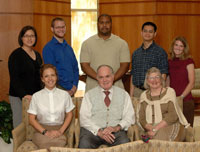 |
|
This year's group of seven interns includes (back row, l to r) Kay Hwang, Chris McDaniel, Jonathan Grant, Hoang-Chuong Dinh Nguyen, Christine May and (front row, l to r) Lindsay Barr, Chaplain Ray Fitzgerald (program director) and Phyllis Danielson-Gillie.
|
Each summer the Clinical Center and the Spiritual Ministry Department host a group of clinical pastoral education (CPE) interns who spend ten weeks learning how to work with patients and families during times of crisis. Under the direction of Dr. Ray Fitzgerald, chief of the Spiritual Ministry Department, the interns spend the summer at the Clinical Center participating in educational activities and interacting with patients, doctors and nurses.
The multi-faith group is typically composed of interns who are training for pastoral ministry, institutional chaplaincy, pastoral counseling or other specialized ministries.
NIH's internship program is accredited by the Association for Clinical Pastoral Education.
Back to Top
Upcoming Events
August 2 (Wednesday)
Noon–1 p.m. Lipsett Amphitheater
Medical Error: Obstacles and Opportunities
Saul Weingart, MD, PhD, Assistant Professor of Medicine, Harvard Medical School, Vice President for Patient Safety, and Director of the Center for Patient Safety, Dana-Farber Cancer Institute
August 9 (Wednesday)
Noon–1 p.m. Lipsett Amphitheater
The Ethics of Health Policy
Steven Pearson, MD, MSc, Special Advisor, Technolgoy and Coverage Policy, Centers for Medicare and Medicaid Services and NIH
August 16 (Wednesday)
Noon–1 p.m. Lipsett Amphitheater
Women's Health and Sex/Gender Research: Perspectives of NIH
Vivian Pinn, MD, Associate Director for Research on Women's Health and Director, Office of Research on Women's Health, Office of Director, NIH
August 23 (Wednesday)
Noon–1 p.m. Lipsett Amphitheater
Ethical Implications of Work Hours in Residency Training
Charles A. Czeisler, MD, PhD, Baldino Professor of Sleep Medicine and Director, Division of Sleep Medicine, Harvard Medical School; Chief, Division of Sleep Medicine, Department of Medicine, Brigham and Women's Hospital
To view other NIH and Clinical Center events, click here.
Back to Top
|
|
Clinical Center News, National
Institutes of Health, Building 10, 10 Center Drive, Room 12C440, Bethesda, MD 20892-1504. Tel: 301-496-6787.
Fax: 301-402-2984. Published monthly for CC employees
by the Office of Communications, Patient Recruitment, and Public Liaison. News, article ideas,
calendar events, letters, and photographs are welcome.
Back to Top
|
|


 The information on this page is archived and provided for reference purposes only.
The information on this page is archived and provided for reference purposes only.